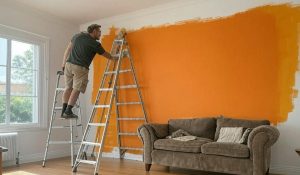Self Employed Painter and Decorator Hourly Rate: A Complete Guide
Setting the right hourly rate as a self-employed painter and decorator in the UK is crucial for building a successful and sustainable business. Charging too little can make it difficult to cover expenses, while pricing too high may deter potential clients.
Whether you are just starting out or looking to adjust your pricing, understanding the industry rates and influencing factors will help you set fair yet profitable charges.
Painters and decorators often charge by the hour or by the project, depending on the job size and complexity. Interior and exterior painting, wallpapering, and cabinet refinishing all have different cost structures, which can affect how much a professional can earn.
This guide explores the average hourly rate for self-employed painters and decorators, the factors influencing pricing, and ways to increase earnings in this trade.
What Is the Average Hourly Rate for a Self-Employed Painter and Decorator in the UK?

The average hourly rate for a self-employed painter and decorator in the UK varies based on experience, location, and project scope. Generally, rates range from £12 to £40 per hour, with experienced decorators commanding higher fees.
Estimated Hourly Rates by Experience Level
| Experience Level | Hourly Rate (GBP) |
| Beginner (0-2 years) | £12 – £18 |
| Intermediate (2-5 years) | £18 – £25 |
| Experienced (5+ years) | £25 – £40+ |
Daily Rates for Painters and Decorators
Since many professionals charge by the day, it’s useful to consider average daily rates:
- Room painting and decorating: Around £161 per day, taking 2-3 days to complete.
- Exterior house painting: Typically £145 per painter per day, with an average job taking 3-4 days when two painters are involved.
- Kitchen cabinet painting: Usually costs around £377 per day, with the full job requiring 4 days.
While these rates provide a general guideline, regional variations play a major role in determining how much a painter can charge.
Regional Pricing Differences
Painters and decorators in London and the South East tend to charge more due to higher living costs and increased demand. In contrast, those in the Midlands, North of England, Wales, Scotland, and Northern Ireland may have lower rates due to lower overhead costs and local market conditions.
Painter and Decorator Rates by City
Below is a breakdown of average hourly and daily rates across various cities and regions in the UK. These figures exclude VAT and callout charges, which may be additional costs depending on the decorator.
| Location | Hourly Rate (£) | Daily Rate (£) |
| London | 31 | 199 |
| Birmingham | 22 | 165 |
| Leeds | 22 | 160 |
| Glasgow | 21 | 167 |
| Manchester | 23 | 164 |
| Bristol | 23 | 178 |
| Edinburgh | 25 | 183 |
| Liverpool | 22 | 154 |
| Southampton | 28 | 175 |
| Cardiff | 22 | 172 |
| Nottingham | 22 | 168 |
| Newcastle Upon Tyne | 22 | 164 |
| Oxford | 36 | 206 |
| Portsmouth | 27 | 171 |
| Milton Keynes | 30 | 203 |
| Aberdeen | 23 | 187 |
| Brighton | 28 | 186 |
| Peterborough | 33 | 215 |
| Cambridge | 28 | 192 |
| Dundee | 25 | 181 |
| York | 21 | 163 |
| Reading | 32 | 202 |
| Swansea | 20 | 156 |
| Belfast | 18 | 141 |
| Carmarthenshire | 18 | 141 |
| Scottish Borders | 18 | 138 |
These rates are approximate averages and may fluctuate based on factors such as experience, project size, and specific customer requirements. Additionally, some painters may offer discounted rates for larger projects or charge extra for urgent jobs or weekend work.
Why Do Rates Vary Between Regions?

Several key factors influence why painter and decorator rates differ so much across the UK:
Cost of Living Differences
Painters in high-cost cities like London, Oxford, and Milton Keynes must charge more to cover their higher overhead costs, including rent, transport, and materials.
Competition and Market Demand
Areas with high competition among decorators often lead to more competitive pricing. However, in places where there is high demand but fewer professionals, such as Reading or Cambridge, painters can charge premium rates.
Type of Work Available
Cities with a higher percentage of commercial projects (e.g., large office buildings, hotels, and retail spaces) tend to have higher rates, as businesses often allocate larger budgets for professional decorating services. In contrast, residential-only areas may see lower pricing due to customers’ tighter budgets.
Experience and Specialisation
Painters who specialise in decorative finishes, period property restoration, or high-end wallpapering can charge significantly more than those offering basic painting services.
Travel and Accessibility
Some decorators factor in travel costs when working in rural or remote areas, which may increase prices for certain locations.
What Factors Influence a Painter and Decorator’s Hourly Rate?

Several factors determine how much a painter and decorator can charge per hour or per project. Understanding these elements can help professionals set a competitive yet profitable rate.
Location
Painters in London, Manchester, and other metropolitan areas often charge higher rates due to demand and the cost of running a business in these regions. In contrast, decorators in rural areas may need to offer lower prices to attract clients.
Experience and Expertise
A painter with years of experience, a solid reputation, and a portfolio of high-quality work can charge significantly more than someone just starting out. Decorators with specialised skills, such as spray painting, period restoration, or wallpapering, can demand higher fees due to the complexity of their work.
Project Type
Not all painting and decorating jobs are priced the same. A standard room painting job is usually cheaper than more complex tasks like cabinet refinishing or wallpapering. Additionally, commercial projects tend to be more lucrative than residential jobs, as businesses often have larger budgets for renovations.
Materials and Overheads
Self-employed painters must factor in paint, brushes, rollers, ladders, protective sheets, and other materials when setting their rates. On average, the material cost for painting a room is around £3,100, while exterior painting supplies cost approximately £250. Clients are often expected to purchase their own paint, but some painters offer to source it for them at an additional charge.
Market Demand and Competition
A high demand for decorators in a particular area allows professionals to set premium rates. However, in areas where competition is fierce, decorators may need to offer competitive pricing to attract clients while maintaining profitability.
How Much Does It Cost to Paint and Decorate Different Areas?

Below is a breakdown of estimated costs for common painting and decorating jobs:
| Job | Estimated Cost (GBP) |
| Paint and decorate a single room | £300 |
| Paint and decorate a living room | £700 |
| Wallpaper a room | £400 |
| Paint hallway, stairs, and landing | £650 |
| Paint entire house interior | £3,000 |
| Paint entire house exterior | £1,300 |
| Repaint skirting boards (per room) | £170 |
| Repaint interior doors (per door) | £120 |
| Paint kitchen cabinet doors | £420 |
| Paint a bathroom | £290 |
| Paint a front door | £351 |
| 1-bedroom flat/house | £1,000 |
| 3-bedroom house | £3,000 |
How Can You Increase Your Earnings as a Painter and Decorator?

Painters and decorators looking to maximise their earnings should consider offering specialised services, improving their marketing, and refining their pricing strategy.
Offer High-Demand Services
Specialist painting services such as kitchen cabinet refinishing, decorative finishes, and wallpapering command higher rates. For example, painting kitchen cabinets can cost up to £1,600 for four days of work, which is significantly more profitable than standard room painting.
Build a Strong Reputation
Word-of-mouth referrals and positive customer reviews help attract more clients willing to pay premium rates. Creating a portfolio showcasing previous work can also help justify higher prices.
Expand to Exterior Painting
Since exterior painting jobs often pay more per day, decorators can increase their income by offering full house exterior painting services, which typically cost around £1,163 for an average-sized house.
Improve Business Marketing
Setting up a professional website, using social media, and listing services on platforms like Checkatrade can help decorators reach more clients and secure better-paying jobs.
Conclusion
The self-employed painter and decorator hourly rate depends on location, experience, and job type, with professionals typically charging between £12 and £40 per hour or £145 to £377 per day for more specialised tasks.
Understanding industry pricing trends and strategically positioning yourself in the market can help ensure long-term business success. By offering high-demand services, maintaining quality work, and leveraging effective marketing, self-employed decorators can increase their earnings and grow their client base.
FAQs
What is the going rate for a self-employed painter and decorator?
The average hourly rate for a self-employed painter and decorator in the UK ranges from £12 to £40 per hour, depending on location, experience, and job complexity. Daily rates typically start from £145 and can go up to £377 for specialised services.
How much does it cost to paint a 3-bedroom house?
The cost to paint the interior of a three-bedroom house in the UK is usually between £2,500 and £3,500, depending on the size of the rooms, the number of coats required, and whether ceilings and woodwork are included.
How much do painters charge for hall, stairs, and landing?
The cost to paint a hallway, stairs, and landing typically ranges between £600 and £900, depending on the height of the walls, surface condition, and the amount of detail work required.
What do most painters charge hourly?
On average, painters in the UK charge between £20 and £30 per hour, though rates can be higher in cities like London or lower in rural areas.
Is it cheaper to hire a painter or do it yourself?
DIY painting can be cheaper in terms of labour costs, but hiring a professional ensures a high-quality finish, proper surface preparation, and efficiency, which may save money in the long run by reducing mistakes or the need for repainting.
How much can a painter charge per room?
The cost to paint a single room varies between £300 and £700, depending on the size of the room, ceiling height, and the type of paint used.
What is the difference between a self-employed painter and a company-based painter?
A self-employed painter works independently, sets their own rates, and manages their own schedule, while a company-based painter is employed by a decorating firm and follows set wages and hours.
How do painters and decorators calculate their pricing?
Pricing is based on factors such as job size, labour time, material costs, location, and any additional services like wallpapering or surface preparation.
Do painters charge extra for materials?
Most decorators provide a labour-only quote and ask clients to supply the paint, but some may include material costs in their pricing for convenience.
How long does it take to paint a house interior?
A standard three-bedroom house interior typically takes 5 to 7 days to paint, depending on surface conditions and the number of coats required.
Can I negotiate the price with a self-employed decorator?
Yes, many self-employed decorators are open to negotiation, especially for larger projects or repeat work, but extremely low offers may affect quality and professionalism.
Do painters and decorators require a deposit before starting work?
Some self-employed decorators may ask for a deposit (typically 10-30%), especially for large projects, to cover initial material costs and secure the job.
What is the best time of year to hire a painter and decorator?
Winter and early spring often have more availability and competitive rates, while summer tends to be busier, leading to longer wait times and higher demand.







